Welcome Letter To New Employee From Manager
[Your Company Logo]
[Company Name]
[Company Address]
[City, State, ZIP Code]
[Date]
Dear [Employee's Name],
I am thrilled to extend a warm welcome to you as the newest member of the [Department/Team Name] at [Company Name]. We are excited to have you on board and look forward to the contributions you will make to our team.
Starting a new journey with a company can be both exciting and a little nerve-wracking, but please know that you are joining a team that values collaboration, innovation, and a dedication to excellence. We believe that your skills and experience will complement our team's efforts and help us achieve our goals.
As your manager, I am committed to supporting your professional growth and success here at [Company Name]. Our company culture promotes open communication, continuous learning, and a strong sense of teamwork. You will find that our team members are always willing to lend a helping hand and share their expertise.
During your initial days, you will undergo an orientation process that will help you become familiar with our company's policies, procedures, and values. You will also have the opportunity to meet your colleagues, learn about your role in detail, and get acquainted with the projects you will be involved in.
Please feel free to reach out to me or any member of our team if you have any questions or need assistance along the way. We believe in fostering a positive and inclusive work environment where everyone's voice is heard and respected.
Once again, welcome to the [Department/Team Name] at [Company Name]. We are excited to have you join us and look forward to achieving great things together.
Best regards,
[Your Name]
[Your Title]
[Department/Team Name]
[Contact Information: Phone Number, Email]
Professional Welcome Letter from Manager
Dear [Employee Name],
Welcome to [Company Name]! On behalf of the entire team, I am pleased to officially welcome you to our organization. We are delighted to have you on board and excited about the skills, ideas, and enthusiasm you will bring to your role as [Job Title].
In the coming days, you will meet your colleagues, get familiar with our systems, and settle into your new responsibilities. Please know that my door is always open if you have any questions, need clarification, or simply wish to talk about your progress.
We believe that you will make a valuable contribution, and we look forward to supporting your growth and success. Once again, welcome to the team—we are happy to have you with us.
Sincerely,
[Manager Name]
[Manager Position]
Casual Welcome Email from Manager
Hi [Employee Name],
Welcome aboard! We’re really excited to have you join us at [Company Name]. Everyone here is looking forward to working with you and learning from the fresh perspective you bring.
Your first few days might feel like a lot of information, but don’t worry—we’re all here to help. Feel free to ask questions anytime, and don’t hesitate to reach out to me directly.
Glad to have you with us, and let’s make this a fun and successful journey together.
Cheers,
[Manager Name]
Creative Welcome Message for a Startup
Dear [Employee Name],
Welcome to the adventure! Joining [Company Name] means you’re not just starting a job—you’re becoming part of a mission. We’re thrilled to have your energy, creativity, and skills as we continue building something remarkable.
At our startup, every idea counts and every effort shapes our future. Don’t be afraid to experiment, innovate, and challenge the norm. You’ll quickly find that your input will have a visible impact.
We’re excited to see where your journey with us takes you. Buckle up—it’s going to be an exciting ride!
Best,
[Manager Name]
Heartfelt Welcome Letter from Manager
Dear [Employee Name],
It gives me great joy to welcome you to [Company Name]. Starting a new chapter in your career is always significant, and I want you to know how valued you already are by our team.
We don’t just see you as an employee—we see you as a part of our family. Your growth and well-being matter to us, and we are here to support you every step of the way.
We are excited about the talents you bring and the new perspectives you will share. Together, we will achieve great things, and I look forward to seeing you thrive in your new role.
Warm regards,
[Manager Name]
Quick and Simple Welcome Email
Hello [Employee Name],
Welcome to [Company Name]! We’re glad to have you on the team and look forward to working with you.
Please let me know if you need anything as you settle in.
Best,
[Manager Name]
Funny Welcome Message for a Lighthearted Team
Hey [Employee Name],
Welcome to [Company Name]! Congratulations—you’ve officially joined the team that runs on coffee, laughter, and the occasional miracle. We’re thrilled you’re here and can’t wait to see how you’ll add your own twist to our daily adventures.
Don’t worry if you get lost in the maze of acronyms—we’ve all been there. Just ask, and someone will gladly help (possibly after offering you another cup of coffee).
We’re excited to have you on board. Let’s do great work—and have some fun while at it!
Cheers,
[Manager Name]
Serious and Official Welcome Letter
Dear [Employee Name],
Welcome to [Company Name]. We are pleased to confirm your appointment as [Job Title], effective [Start Date]. As part of your onboarding, you will receive full access to company policies, codes of conduct, and compliance guidelines.
Your role is crucial to our continued success, and we trust that you will perform your responsibilities with professionalism and dedication. Please take time to review the enclosed materials and complete the required onboarding steps within the first week.
We look forward to a mutually rewarding working relationship.
Sincerely,
[Manager Name]
[Manager Title]
Provisional Welcome Letter (For Probationary Role)
Dear [Employee Name],
Welcome to [Company Name]! We are excited to have you join us as [Job Title]. Your initial period with us will be a probationary phase of [X months], during which you will be introduced to your responsibilities and performance expectations.
We are confident in your abilities and believe you will meet the standards required for permanent employment. Throughout this period, you will have access to guidance and support to ensure your success.
We look forward to working with you and hope this marks the beginning of a long and rewarding career at our company.
Sincerely,
[Manager Name]
What is a welcome letter to a new employee and why is it important?
A welcome letter to a new employee from a manager is a formal or informal communication that marks the start of their journey in the organization.
It sets the tone for the employee’s first impressions, reinforces company culture, and helps ease the transition into a new role.
By showing appreciation and encouragement early, managers can boost morale, improve engagement, and create a sense of belonging.
Who should send the welcome letter to a new employee?
- Direct manager or supervisor (most common and preferred).
- Department head or team leader in some cases.
- In small companies, the business owner or CEO may send it.
- In collaborative teams, the letter may be co-signed by multiple managers.
Whom should the welcome letter be addressed to?
- The new employee directly by name.
- Sometimes copied to the HR department for records.
- In rare cases, a team-wide message can be shared, but the direct message to the employee should always come first.
When should a welcome letter be sent?
- A few days before the employee’s first working day.
- On the morning of their first day.
- For provisional or probationary employees, right after signing the contract.
- For remote workers, it may be sent earlier to help them feel included before official onboarding.
How should a manager write and send a welcome letter?
- Start with a warm greeting.
- Acknowledge the role and contribution the new hire is expected to make.
- Offer support, resources, and guidance.
- Keep the tone aligned with company culture (formal, casual, creative).
- Send through the appropriate medium—printed letter for official hires, or email/message for quick and informal welcomes.
How many versions of a welcome letter should a company have?
- At least one formal template for official hires.
- One casual or creative version for lighter environments.
- Special versions for probationary hires, remote workers, and senior-level hires.
- Optional quick/short message templates for time-sensitive situations.
Requirements and prerequisites before sending a welcome letter
- Confirm hiring process and contract finalization.
- Ensure employee’s start date and reporting details are clear.
- Gather all onboarding resources (handbook, policies, system access).
- Personalize the letter with the employee’s name, role, and start date.
Formatting guidelines for welcome letters
- Length: 1 to 3 short paragraphs for emails; 3 to 5 paragraphs for formal letters.
- Tone: Should match company culture (professional, casual, or creative).
- Style: Clear, concise, and encouraging.
- Etiquette: Always address by name, avoid generic phrasing, and ensure correct details.
- Mode: Printed letter for formality; email/message for casual and fast communication.
After sending the welcome letter – what should managers do?
- Arrange a formal onboarding session or orientation.
- Personally greet the new employee on their first day.
- Introduce them to the team and mentor, if applicable.
- Follow up within the first week to check on progress and comfort level.
Common mistakes to avoid when writing a welcome letter
- Being too generic or impersonal.
- Forgetting to include the employee’s name or role.
- Sending it too late (after the employee has already joined).
- Using an overly stiff or inappropriate tone for company culture.
- Not following up with action after the welcome.
Tricks and tips for writing the perfect welcome letter
- Personalize with role-specific or team-specific details.
- Keep the message warm but concise.
- Align the tone with company branding.
- Send a copy to HR for employee records.
- Pair the letter with a welcome kit or orientation plan for greater impact.
Elements and structure of a welcome letter to new employee
- Subject line or headline (for emails).
- Greeting with the employee’s name.
- Welcome statement and acknowledgment of role.
- Information about what’s next (first day, onboarding, expectations).
- Offer of support and availability.
- Closing with manager’s name and title.
Compare and contrast: welcome letters vs. team announcements
- Welcome letters are personalized messages directly to the employee.
- Team announcements are group messages introducing the new hire to colleagues.
- Letters are private and focused on the employee, while announcements are public and focus on team integration.
- Both should complement each other, not replace one another.
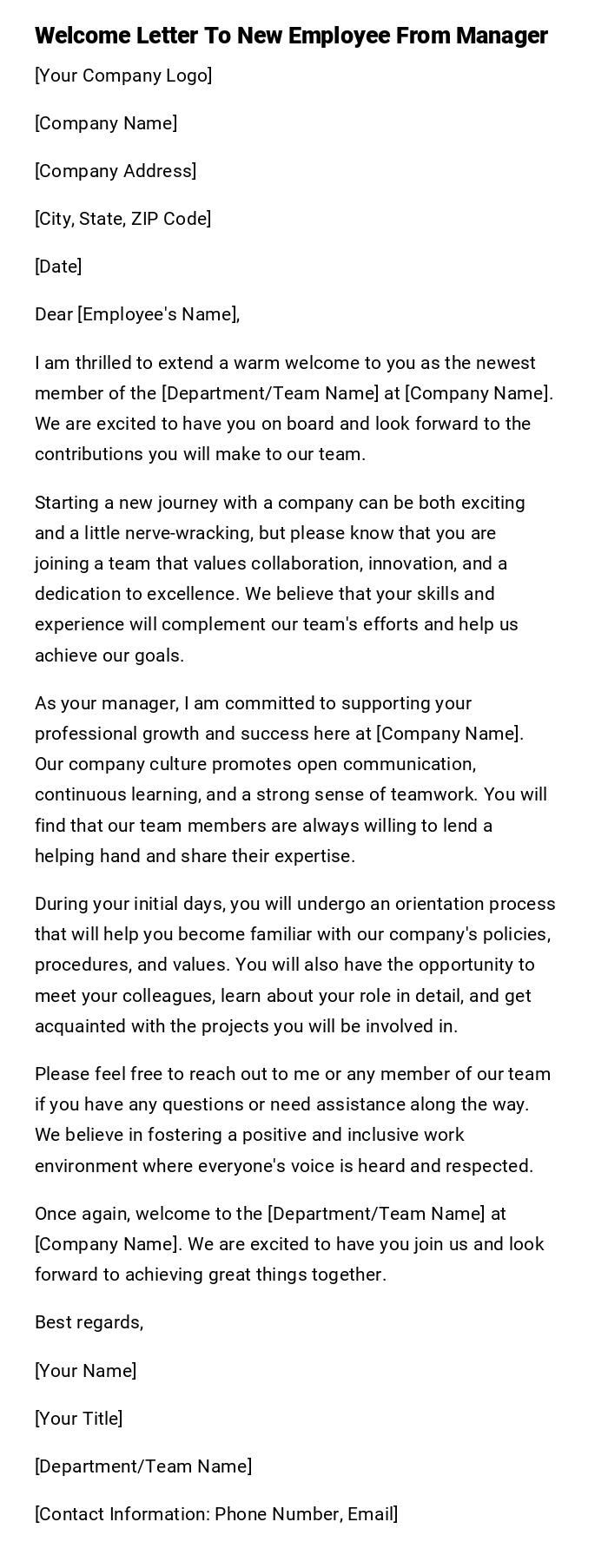
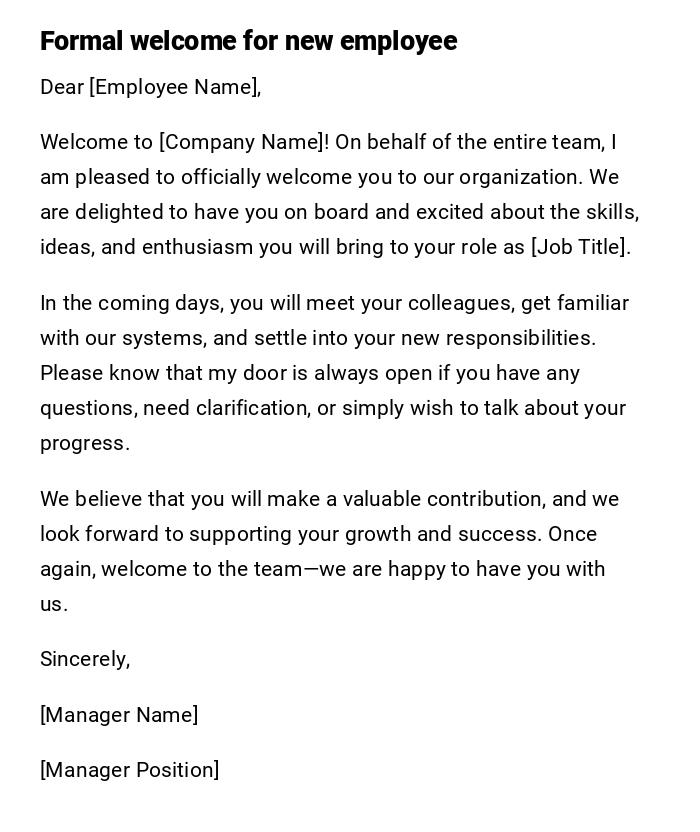
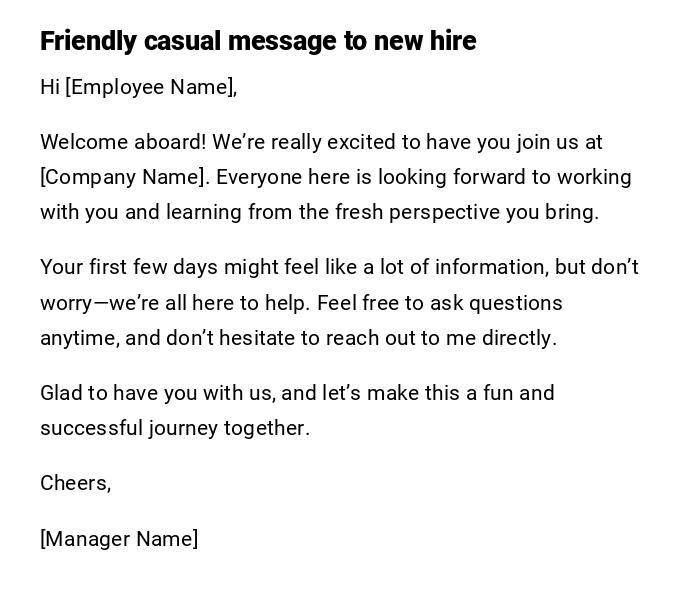
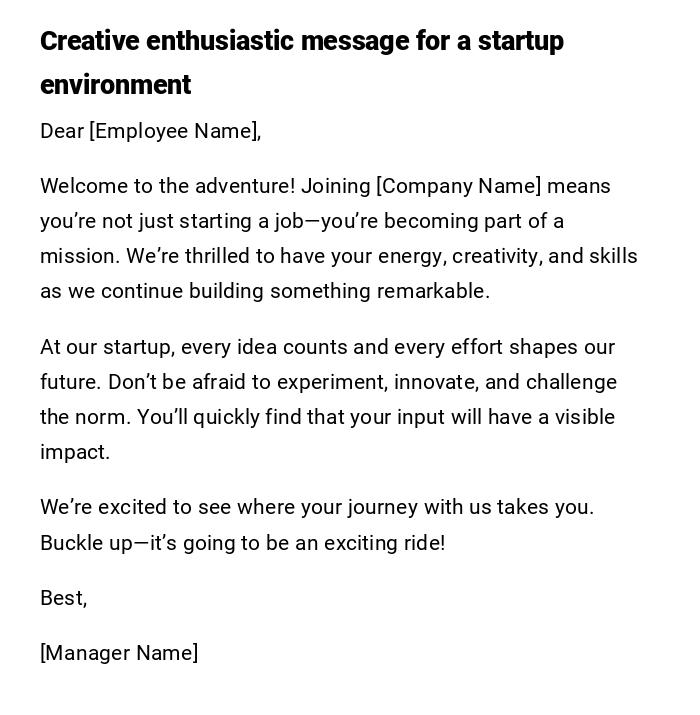
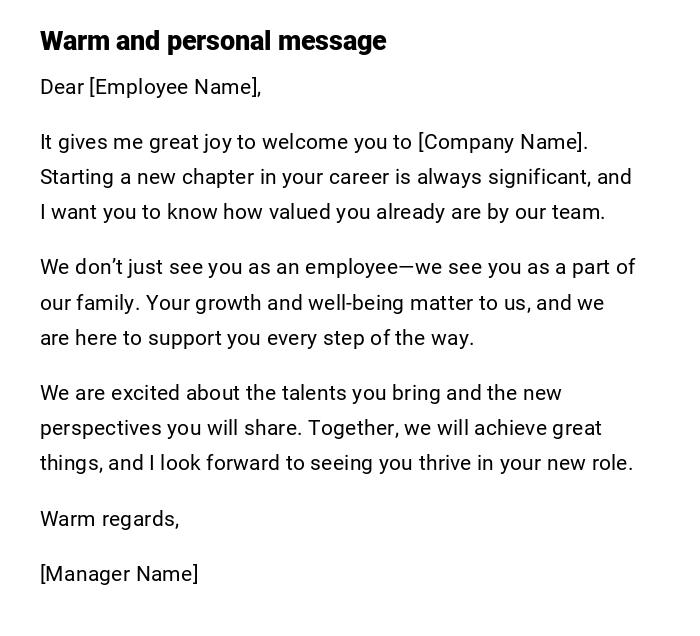
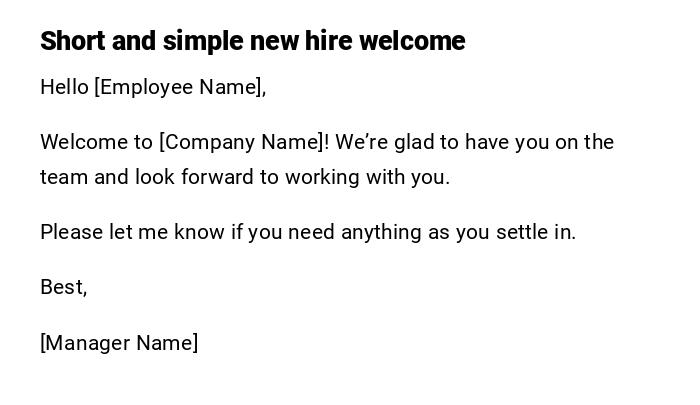
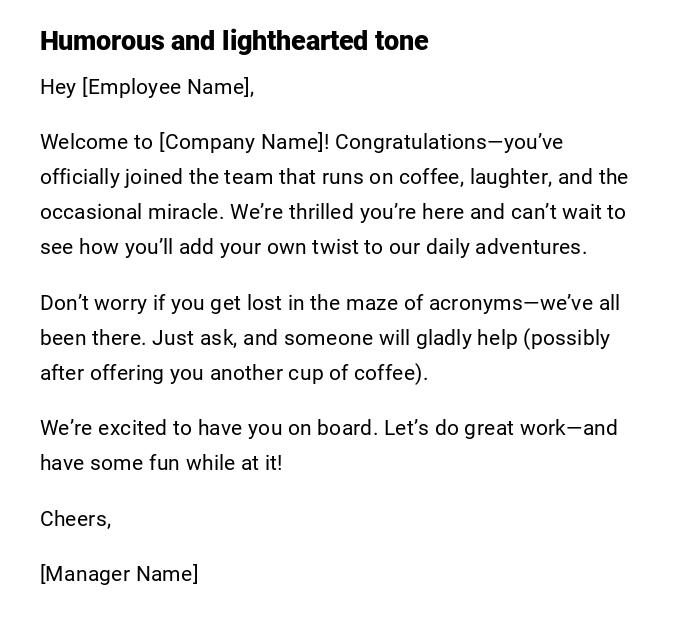
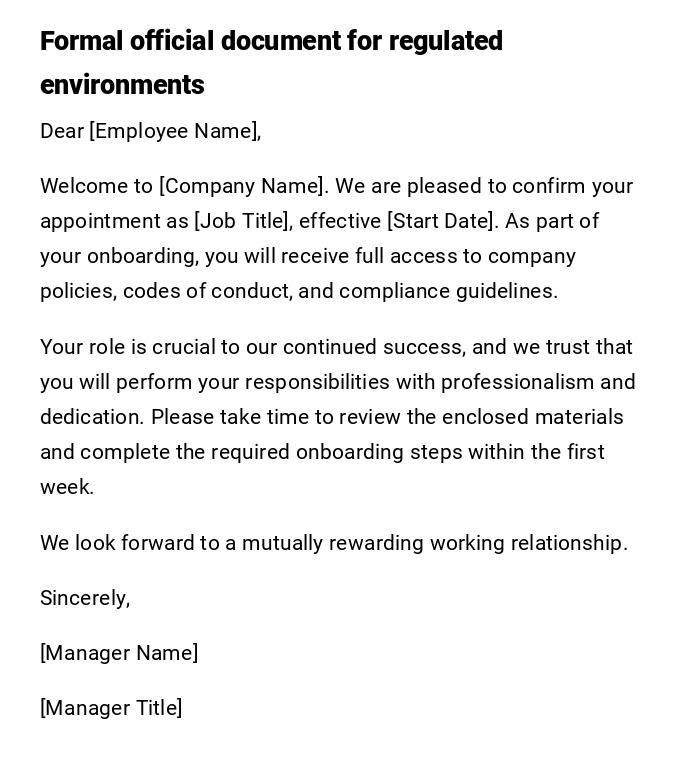
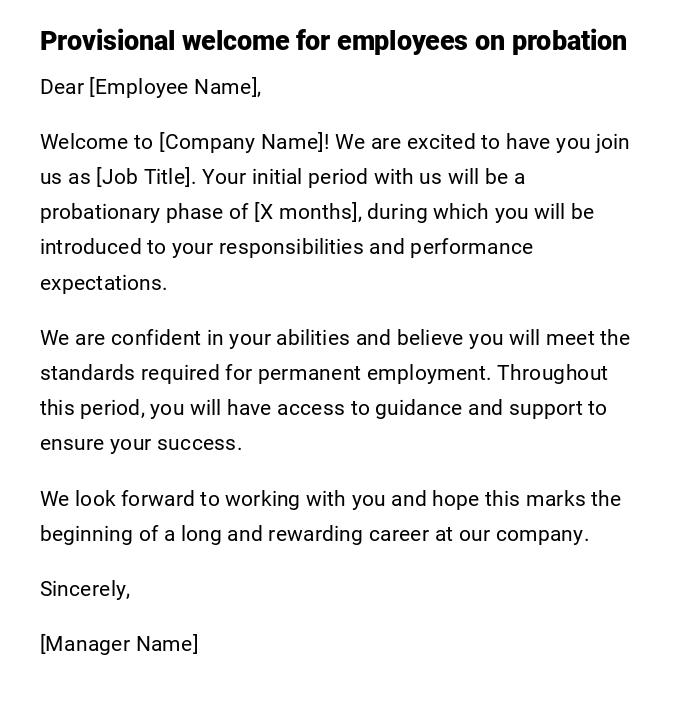

 Download Word Doc
Download Word Doc
 Download PDF
Download PDF